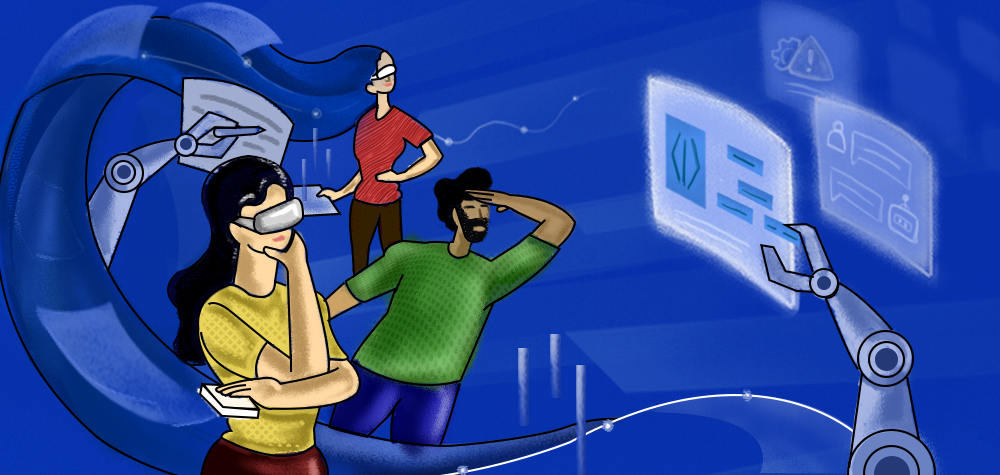Reimagining the future of ITSM with generative AI
08 mins read

The need for generative AI-infused ITSM
After generative AI reached the peak of inflated expectations on the Gartner® Hype Cycle for AI in 2023, two-thirds of enterprises have already integrated generative AI into their processes. Why this pursuit, you ask? Driven by predefined algorithms, existing AI applications in IT service delivery and management are restricted to merely offering predictions or classifications. On the other hand, generative AI can provide contextual conversational experiences by dynamically creating content-be it text, images, or videos-fostering impeccable service experiences. So, let's explore how enterprises can leverage these capabilities in ITSM.
Leveraging LLMs for resolving L1 incidents
The current chatbots deployed by most IT service desk teams have limited functionality and mostly aren't capable of completely understanding user issues, let alone helping resolve them. But with the application of generative AI technologies like LLMs, IT service desk teams might soon be able to free up their technicians completely from handling L1 incidents, while also not compromising on the quality and relevance of the responses and resolutions. With the advent of multi-modal LLMs, such virtual agents will be able to collect detailed information through screenshots and screen recordings to diagnose user issues better. Recent advancements in technologies like retrieval-augmented generation (RAG) can also enable these virtual agents to provide accurate and relevant resolutions by referring to the information and knowledge specific to that organization, in addition to the LLMs' vast training data.
Redefining SLAs with intelligent escalations and communication
Generative AI goes beyond resolving basic L1 incidents, proving instrumental in handling complex scenarios-whether a high-priority incident affecting a business-critical resource or ensuring on-time onboarding of multiple users. Instead of waiting for SLAs to turn red, generative AI can analyze historical trends, business importance, and user sentiment. Then, it can smartly escalate tickets likely to breach SLAs to experts in advance, ensuring timely resolution. Further, during this process, generative AI can generate on-demand communications to keep stakeholders informed with contextual updates rather than just boilerplate notifications throughout the ticket journey.
Enriching user experiences while handling tickets
IT service desk teams must deliver remarkable user experiences while also accelerating employee productivity. Generative AI can be embedded across various user touch points to achieve these twin goals. Instead of rigid and static responses rendered by existing virtual agents, LLM-powered virtual IT service desk agents can understand user intent, emotions, and dynamically craft personalized responses to user issues, assisting them better and faster. Also, ticket forms can potentially be replaced by conversations between end users and such virtual agents to collect relevant information, as in a short Q&A, without overloading the user with outdated forms.
Also, incident resolution for end users can become more proactive than just waiting for a user to report the issue to the IT service desk. With natural language case extraction, generative AI can pick up user grievances from intranet forums or internal collaboration platforms and convert them into tickets for swifter resolution.
Facilitating risk-free change management with strategic insights
Enterprises handle multiple changes, including server upgrades and firewall adjustments, which requires IT change managers to triage the change queue quickly and prevent conflicts. However, searching through multiple change records for affected configuration items (CIs), services, or overlapping schedules can be tedious and error-prone.
Generative AI empowers IT change managers and owners with strategic insights, offering a swift summary of the change landscape without the need to hop tabs. These could indicate potential overlaps in CIs, loopholes in rollout and contingency plans, improper demarcation of roles and responsibilities, collisions between changes, and more.
Additionally, to avoid change failures, IT teams must assess the risks caused by the change by looking beyond numbers. Apart from predicting and assigning risks, generative AI can provide advisories highlighting the potential services that could experience downtime, the critical resources that could be affected, the business impact, and ultimately, the ways to minimize those risks.
Managing endpoint anomalies and compliance with ease
By intelligently extracting information from numerous sources, including endpoints, installed applications, and activity logs, generative AI can assist IT teams by automatically analyzing issues like slowness or application crashes that might affect user productivity. It can help with offering actionable recommendations, such as suggesting RAM updates, hardware replacements, or software updates to users.
Moreover, generative AI can simplify strenuous activities like compliance management through effective case summarization. Instead of manually sifting through a trove of purchase orders, contracts, and licenses related to different products or vendors, generative AI can summarize them at a glance, intelligently alerting IT teams of critical requirements like license renewals well in advance.
Fostering a dynamic and relevant knowledge base
From having outdated or irrelevant solutions at hand to discovering relevant answers outside the ITSM platform, it can be painstaking for users to access the right solutions to self-resolve issues.
Instead, generative AI provides a convenient method to overcome this challenge. When end users report issues to the service desk, generative AI can scan for apt solutions or DIY methods from public sources like YouTube and external forums. Also, with advancements like RAG, generative AI can ground its information on internal IT documentation, improving context. With this, it can furnish relevant solutions by guiding end users step-by-step, simplifying knowledge discovery.
Also, by factoring in solutions from external and internal sources, including organic conversations, work logs, histories, documentation, resolutions, and collaboration support hubs, generative AI can populate the knowledge base with up-to-date information to close knowledge gaps.
Modernizing service experiences with generative AI
From resolving incidents to managing assets and updating knowledge bases, these are some of the different ways generative AI can help IT teams reimagine service experiences in the near future. The time has come for enterprises to tap the transformational capabilities of generative AI due to its potential as the mainstay of intelligent automation in ITSM in the coming years.

